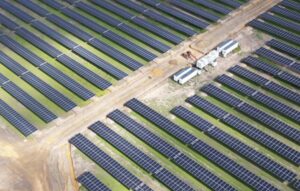 The recent federal government budget announcement has presented a promising result for electrification and energy efficiency.
The recent federal government budget announcement has presented a promising result for electrification and energy efficiency.
Over $1 billion will be provided to households to incentivise the uptake of efficient, electric appliances and to implement energy efficiency measures. A further $300 million, to be matched by state governments, will be used to upgrade social housing.
This is in addition to the $200 million already committed by the federal government for 400 neighbourhood batteries across the country.
But what role can neighbourhood batteries play in the electrification of households and businesses?
The short answer is, the more distributed solar and demand for electricity – especially in the evenings – the greater the need for storage on the distribution networks. However, the role of neighbourhood batteries may not be as simple as you might expect.
More storage to manage distributed solar generation
Australia already has the most solar per capita in the world. This budget measure is another boost for residential solar, through the provision of accessible loans for households to install solar panels.
With more solar in the system and more electrified homes, the need for storage – particularly where the energy is being produced and consumed – will grow.
We must drastically increase storage across the National Electricity Market (NEM). According to the Australian Energy Market Operator’s (AEMO) 2022 Integrated System Plan, we may need an eye-watering 63GW of storage in the NEM by 2050.
The AEMO ISP Step Change scenario assumes ~40GW of this will be distributed energy resources (DER) built in the NEM based on the rational economic decisions of those responsible for decisions behind the meter (i.e. home batteries).
The capital cost (CAPEX) of installing this DER – which could be in the region of $50 billion – is not included in the existing AEMO ISP Step Change $383 billion CAPEX ($Nominal) spend. This CAPEX is unspecified in the model as an input assumption, however, there is no government storage policy at this stage to enable this to happen.
For many, home batteries are out of reach due to costs or housing constraints, and most people may never see a return on investment.
Vehicle-to-home technology in electric vehicles (EVs) is another form of distributed storage, but is still in its infancy and not currently available in most EV models. Additionally, EVs are physically dynamic: they could be plugged in one day and absent for a week.
Neighbourhood batteries – which are static and can be operated for reliable storage when need is highest – store energy from local solar and distribute it back into the community in the evening. In many cases, they are the only communal asset to store this energy on the distribution network.
Increased capacity for solar and electrification
The increased funding from the federal Budget will undoubtedly increase the uptake of solar PV and electric appliances, such as reverse cycle air conditioners and hot water heat pumps.
As a result of this, the grid will be put under an increased level of stress as electricity demand and solar exports both rise. With every additional home that electrifies, we will need capacity in the network.
Look at what happened recently in South Australia. In October 2022, SA Power Networks’ distribution network exported 236MW of power in reverse flows all the way back up to the high-voltage transmission grid.
This creates instability in the grid and will need to be managed as rooftop solar is going to increase from the current 15GW to reach 70GW by 2050. Such events demonstrate both the opportunity and need for significant storage within the distributed network area.
While there are several ways Distribution Network Service Providers (DNSPs) can deal with network constraints, such as network augmentation and transformer upgrades (static solutions to raise network capacity), neighbourhood batteries can provide dynamic support to ease strains on the network by powering up during the day and discharging during peak times.
In addition to managing network constraints, and unlike network augmentation, neighbourhood batteries deliver a far wider range of benefits, including decarbonisation.
Not only could this help to reduce the number of customers who are export limited, thereby improving the payback of their solar system – it would mean their excess solar energy is stored locally to be shared amongst the community once the sun is no longer shining.
Energy equity
Neighbourhood batteries may help to achieve greater energy equity. While it might be technically feasible for every household to have a behind-the-meter battery, it’s not currently realistic. Just as not everyone currently, for a variety of reasons, has solar PV.
Batteries can help redistribute renewable energy to residents that are locked out of solar (renters, apartment dwellers, unsuitable roofs). All homes within the battery’s catchment area, not just those with solar, would be able to consume electricity with higher renewable content.
Think of a community battery like a bus stop. It is installed in a neighbourhood at no cost to the residents, but provides access to affordable transport for everybody. Without the bus stop, all the residents would be forced to rely on more expensive alternatives, like Uber or private car ownership.
Similarly, neighbourhood batteries offer a public service, sharing and time-shifting of locally produced energy, while bolstering the capacity of the distribution network, and incentivising more DER (Distributed Energy Resources, rooftop solar in particular). Instead of situating costs to the individual or private household (like Uber or car ownership), a neighbourhood battery is a more equitable approach allowing everyone in the same network to access more locally produced renewable energy.
Increased awareness
As Australia accelerates towards becoming a ‘renewable energy superpower’, citizens and communities have an important role to play. An increased understanding and appreciation of both our energy system and personal electricity usage will be crucial to ensure effective expenditure of Australia’s first electrification budget.
Neighbourhood batteries can raise awareness about energy and electrification, thereby providing communities with a shared asset in the perpetual fight against climate change, rising energy costs, and grid instability.
As a placemaking opportunity, a battery can become a veritable work of art and source of community pride, as showcased by the Fitzroy North Community Battery. Activating communities and starting conversations about the electrification opportunities is one crucial part of empowering households to make the most of the federal government’s support measures.
Supporting more (climate-friendly) EV chargers
Electric vehicles will see increased funding through the new federal Budget, with $5.2 million over four years for the development of a national charging infrastructure mapping.
The co-location of EV chargers alongside neighbourhood scale batteries could offer a climate and community-friendly charging system for electric vehicles.
By leveraging tariffs which favour batteries, EV chargers co-located with neighbourhood batteries could send dynamic price signals to encourage customer behaviour. Thus, these EV charges would actually benefit the local network and environment.
A battery and EV combination would likely incentivise EV charging during the day when renewable energy content is highest and vice versa in the evenings.
Yarra Energy Foundation is planning to install the first co-located EV charger with a neighbourhood battery in Melbourne under funding from the Victorian government’s Neighbourhood Battery Initiative.
Additionally, a co-located community battery and EV charger will allow for a faster EV charger than a standard household charger, without having to upgrade the network in that location. This is a fantastic alternative for those wanting to buy an EV but are unable to install an EV charger at their home, either due to space or cost constraints, or because they rent.
Summary
So, what role will community batteries play in the electrification of our country? The intensifying demand on the distribution network from electrification (including the transition to EVs) coupled with policies which support solar accelerate the rise of electricity consumption and localised generation of renewable energy.
Without question, neighbourhood batteries and various other forms of storage will be required to dynamically smooth both the supply and demand in the management of networks; and make renewable energy an increasingly localised phenomenon
Yarra Energy Foundation is excited about Australia’s first electrification budget and are equally as excited to showcase, witness and explore the full potential of neighbourhood-scale storage.
Lloyd Heathfield is project officer at Yarra Energy Foundation










